Business Strategy Report: Vodafone's Macro and Micro Analysis
VerifiedAdded on 2020/10/22
|16
|5232
|134
Report
AI Summary
This report provides a comprehensive analysis of Vodafone's business strategy. It begins with an introduction to business strategy and its influence by macro environmental factors, particularly within the UK telecommunications market. The report then delves into the PESTLE analysis of Vodafone, evaluating political, economic, socio-cultural, technological, legal, and environmental factors influencing the company's operations globally, with a focus on the UK market. Further, it explores Vodafone's internal environment and organizational capabilities, including its mission statement, strategic capabilities, and the application of the VRIO/VRIN model to assess its resources and competitive advantages. The analysis also highlights Vodafone's strengths and weaknesses. The report concludes with an overview of strategic direction and how Vodafone leverages its resources to maintain a competitive edge in the market.

BUSINESS
STRATEGY
STRATEGY
Paraphrase This Document
Need a fresh take? Get an instant paraphrase of this document with our AI Paraphraser
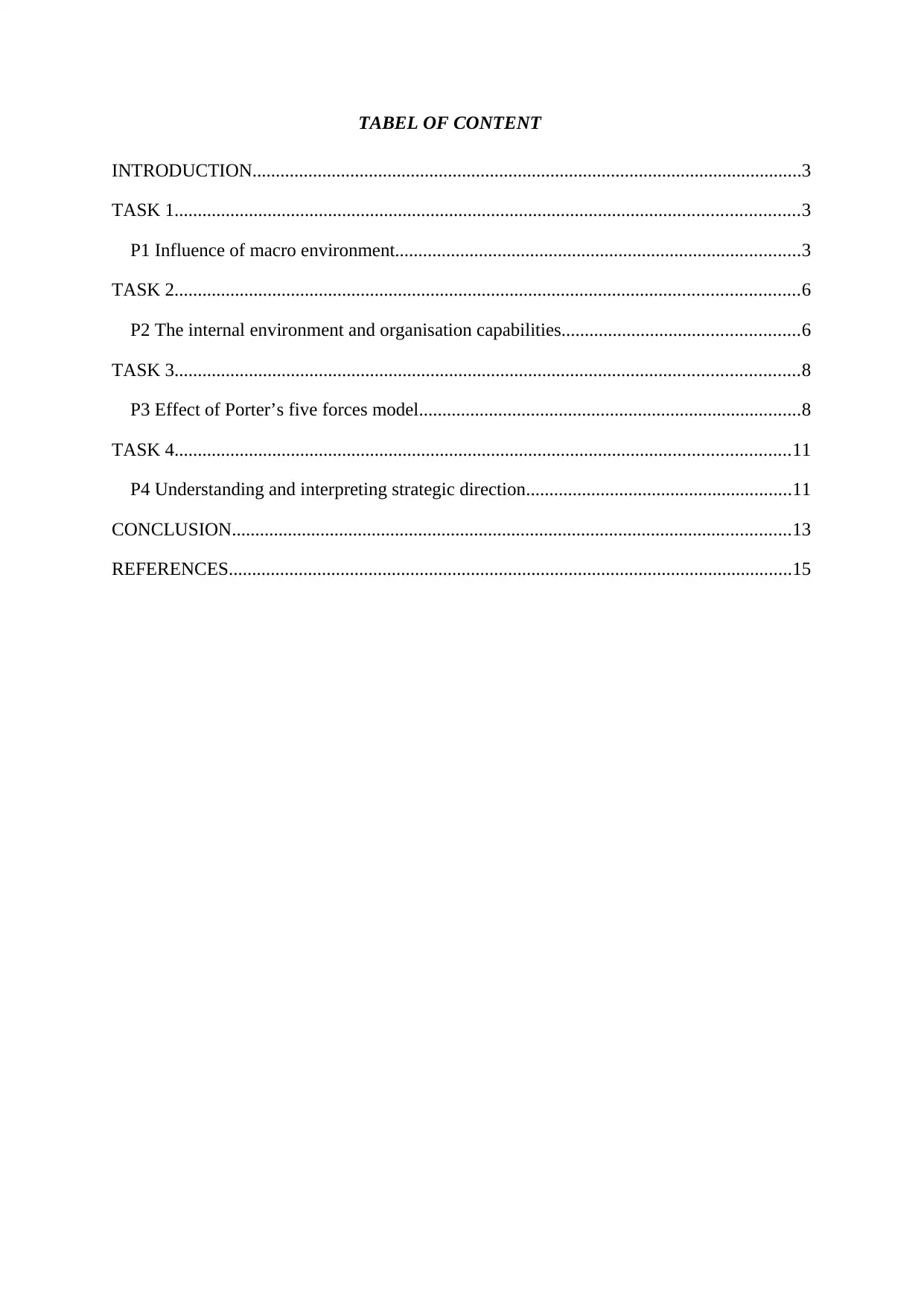
TABEL OF CONTENT
INTRODUCTION......................................................................................................................3
TASK 1......................................................................................................................................3
P1 Influence of macro environment.......................................................................................3
TASK 2......................................................................................................................................6
P2 The internal environment and organisation capabilities...................................................6
TASK 3......................................................................................................................................8
P3 Effect of Porter’s five forces model..................................................................................8
TASK 4....................................................................................................................................11
P4 Understanding and interpreting strategic direction.........................................................11
CONCLUSION........................................................................................................................13
REFERENCES.........................................................................................................................15
INTRODUCTION......................................................................................................................3
TASK 1......................................................................................................................................3
P1 Influence of macro environment.......................................................................................3
TASK 2......................................................................................................................................6
P2 The internal environment and organisation capabilities...................................................6
TASK 3......................................................................................................................................8
P3 Effect of Porter’s five forces model..................................................................................8
TASK 4....................................................................................................................................11
P4 Understanding and interpreting strategic direction.........................................................11
CONCLUSION........................................................................................................................13
REFERENCES.........................................................................................................................15

INTRODUCTION
Business strategy is defined as set of procedure which gives the overall direction to the
firm that is different from the competitor. These strategies make the company distinct from
its competitor. In a global market firm business strategy is influenced by the MACRO factors
which are uncontrollable in nature. Telecommunication sector is getting boon in global
market. The market is getting competitive day by day as the user of mobile are increasing in a
rapidly. In U.K. telecommunication market is getting competitive and it became quite
difficult for the companies to survive in this scenario (Azar, 2011). The main competitors are
Vodafone, BT, EE, Three UK, O2, Virgin, and TalkTalk in the UK. Vodafone Group Plc is
world’s second largest mobile phone company. Till March 2018, Vodafone U.K. has 17.5
million subscriber and enjoys the 3rd position in the national market.
TASK 1
P1 Influence of macro environment
The macro environment is nothing but the external factors which influence an organization’s
decision making and strategy. Macro environment affects the GDP, spending and fiscal
policy. Influence on a company of macro environment factors majorly depends on how much
company’s economy depends on the health of the overall economy. Macro environment
greatly influences the general public and control their spending in the market (Ackermann
and Audretsch, 2013)(Annabi, and McGann, 2013). Consumers’ reactions to the macro
environment are considered as a gauge for an organizations economy’s health.
There are majorly two types of business environment namely micro and macro.
Micro factors also include those factors which cannot be controlled by the company. Some of
them are the general public, competition, suppliers and the resellers. These factors are very
tangible and we can never predict the outcome of these factors. The macro factor which also
influences the organization is of many types. They include political, economical, socio-
cultural, technological, legal and environmental factors.
We will study here the PESTLE analysis of Vodafone. Vodafone is British company which
has expanded its reach all over the world. Now Vodafone operates its service in the continent
such as Asia, Europe, Africa, USA as well. Vodafone has a market capitalization of 82.3
billion dollars and it has partnership with almost 50 countries worldwide. We will now study
the PESTLE analysis of Vodafone.
Business strategy is defined as set of procedure which gives the overall direction to the
firm that is different from the competitor. These strategies make the company distinct from
its competitor. In a global market firm business strategy is influenced by the MACRO factors
which are uncontrollable in nature. Telecommunication sector is getting boon in global
market. The market is getting competitive day by day as the user of mobile are increasing in a
rapidly. In U.K. telecommunication market is getting competitive and it became quite
difficult for the companies to survive in this scenario (Azar, 2011). The main competitors are
Vodafone, BT, EE, Three UK, O2, Virgin, and TalkTalk in the UK. Vodafone Group Plc is
world’s second largest mobile phone company. Till March 2018, Vodafone U.K. has 17.5
million subscriber and enjoys the 3rd position in the national market.
TASK 1
P1 Influence of macro environment
The macro environment is nothing but the external factors which influence an organization’s
decision making and strategy. Macro environment affects the GDP, spending and fiscal
policy. Influence on a company of macro environment factors majorly depends on how much
company’s economy depends on the health of the overall economy. Macro environment
greatly influences the general public and control their spending in the market (Ackermann
and Audretsch, 2013)(Annabi, and McGann, 2013). Consumers’ reactions to the macro
environment are considered as a gauge for an organizations economy’s health.
There are majorly two types of business environment namely micro and macro.
Micro factors also include those factors which cannot be controlled by the company. Some of
them are the general public, competition, suppliers and the resellers. These factors are very
tangible and we can never predict the outcome of these factors. The macro factor which also
influences the organization is of many types. They include political, economical, socio-
cultural, technological, legal and environmental factors.
We will study here the PESTLE analysis of Vodafone. Vodafone is British company which
has expanded its reach all over the world. Now Vodafone operates its service in the continent
such as Asia, Europe, Africa, USA as well. Vodafone has a market capitalization of 82.3
billion dollars and it has partnership with almost 50 countries worldwide. We will now study
the PESTLE analysis of Vodafone.
⊘ This is a preview!⊘
Do you want full access?
Subscribe today to unlock all pages.

Trusted by 1+ million students worldwide
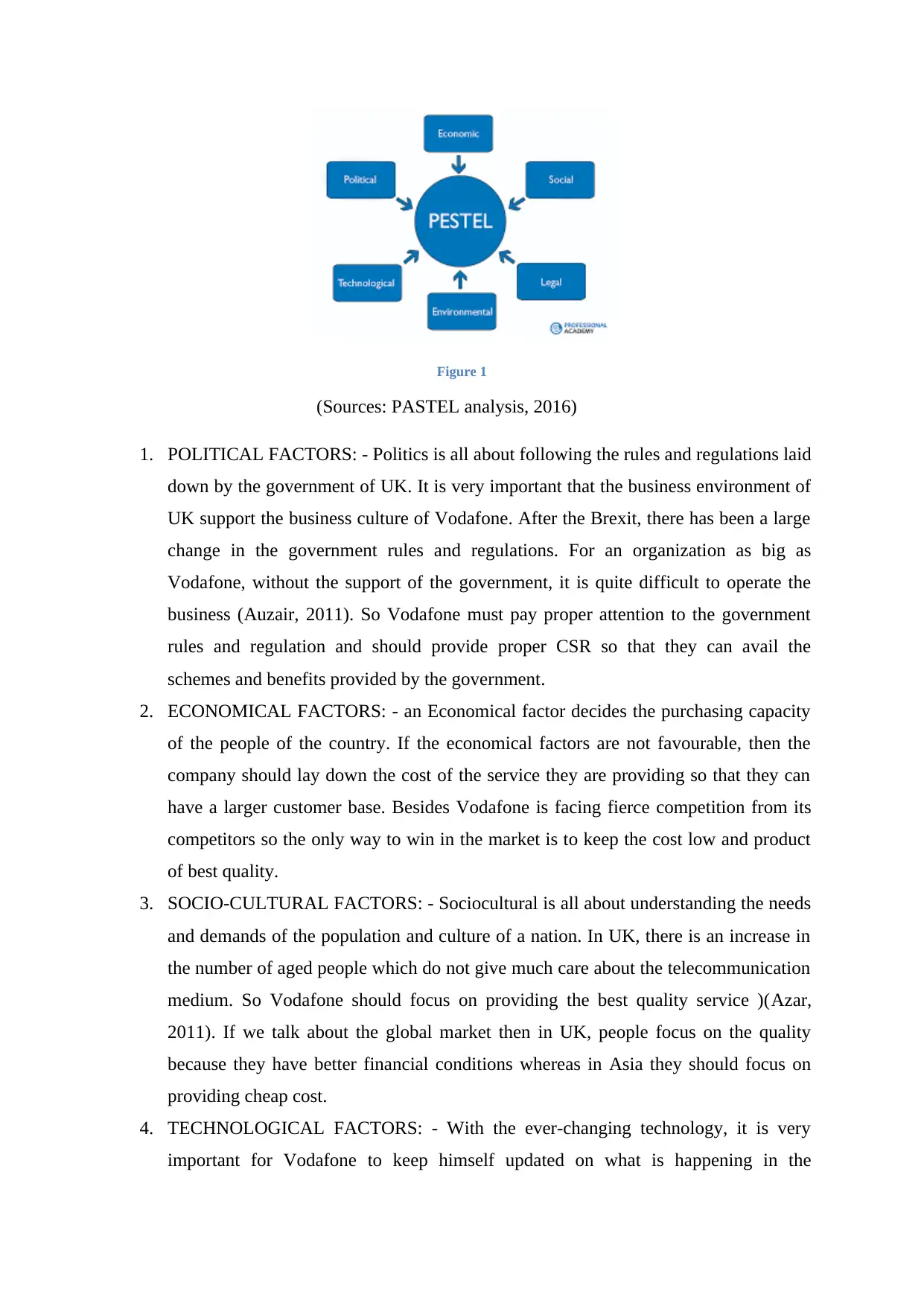
Figure 1
(Sources: PASTEL analysis, 2016)
1. POLITICAL FACTORS: - Politics is all about following the rules and regulations laid
down by the government of UK. It is very important that the business environment of
UK support the business culture of Vodafone. After the Brexit, there has been a large
change in the government rules and regulations. For an organization as big as
Vodafone, without the support of the government, it is quite difficult to operate the
business (Auzair, 2011). So Vodafone must pay proper attention to the government
rules and regulation and should provide proper CSR so that they can avail the
schemes and benefits provided by the government.
2. ECONOMICAL FACTORS: - an Economical factor decides the purchasing capacity
of the people of the country. If the economical factors are not favourable, then the
company should lay down the cost of the service they are providing so that they can
have a larger customer base. Besides Vodafone is facing fierce competition from its
competitors so the only way to win in the market is to keep the cost low and product
of best quality.
3. SOCIO-CULTURAL FACTORS: - Sociocultural is all about understanding the needs
and demands of the population and culture of a nation. In UK, there is an increase in
the number of aged people which do not give much care about the telecommunication
medium. So Vodafone should focus on providing the best quality service )(Azar,
2011). If we talk about the global market then in UK, people focus on the quality
because they have better financial conditions whereas in Asia they should focus on
providing cheap cost.
4. TECHNOLOGICAL FACTORS: - With the ever-changing technology, it is very
important for Vodafone to keep himself updated on what is happening in the
(Sources: PASTEL analysis, 2016)
1. POLITICAL FACTORS: - Politics is all about following the rules and regulations laid
down by the government of UK. It is very important that the business environment of
UK support the business culture of Vodafone. After the Brexit, there has been a large
change in the government rules and regulations. For an organization as big as
Vodafone, without the support of the government, it is quite difficult to operate the
business (Auzair, 2011). So Vodafone must pay proper attention to the government
rules and regulation and should provide proper CSR so that they can avail the
schemes and benefits provided by the government.
2. ECONOMICAL FACTORS: - an Economical factor decides the purchasing capacity
of the people of the country. If the economical factors are not favourable, then the
company should lay down the cost of the service they are providing so that they can
have a larger customer base. Besides Vodafone is facing fierce competition from its
competitors so the only way to win in the market is to keep the cost low and product
of best quality.
3. SOCIO-CULTURAL FACTORS: - Sociocultural is all about understanding the needs
and demands of the population and culture of a nation. In UK, there is an increase in
the number of aged people which do not give much care about the telecommunication
medium. So Vodafone should focus on providing the best quality service )(Azar,
2011). If we talk about the global market then in UK, people focus on the quality
because they have better financial conditions whereas in Asia they should focus on
providing cheap cost.
4. TECHNOLOGICAL FACTORS: - With the ever-changing technology, it is very
important for Vodafone to keep himself updated on what is happening in the
Paraphrase This Document
Need a fresh take? Get an instant paraphrase of this document with our AI Paraphraser
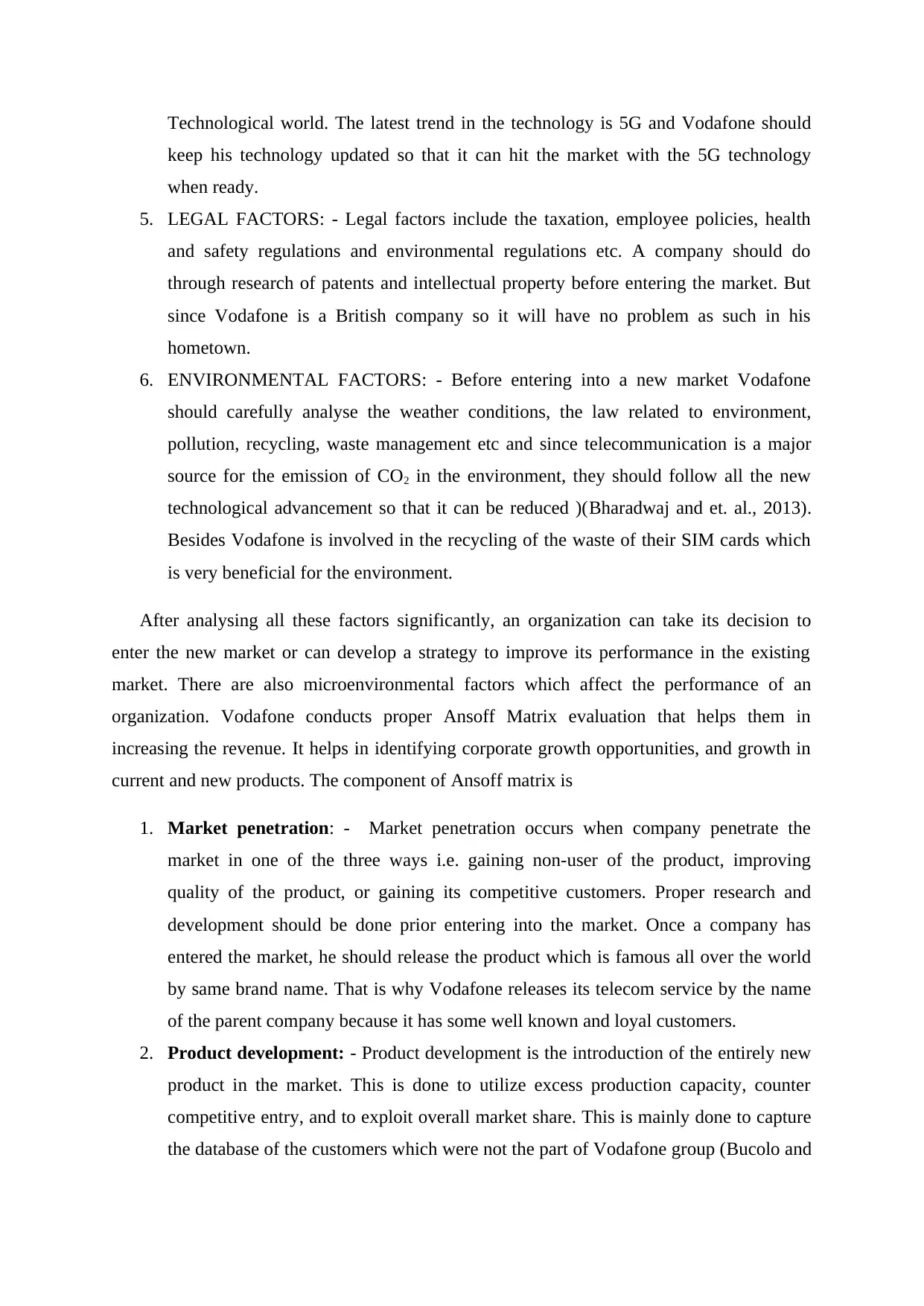
Technological world. The latest trend in the technology is 5G and Vodafone should
keep his technology updated so that it can hit the market with the 5G technology
when ready.
5. LEGAL FACTORS: - Legal factors include the taxation, employee policies, health
and safety regulations and environmental regulations etc. A company should do
through research of patents and intellectual property before entering the market. But
since Vodafone is a British company so it will have no problem as such in his
hometown.
6. ENVIRONMENTAL FACTORS: - Before entering into a new market Vodafone
should carefully analyse the weather conditions, the law related to environment,
pollution, recycling, waste management etc and since telecommunication is a major
source for the emission of CO2 in the environment, they should follow all the new
technological advancement so that it can be reduced )(Bharadwaj and et. al., 2013).
Besides Vodafone is involved in the recycling of the waste of their SIM cards which
is very beneficial for the environment.
After analysing all these factors significantly, an organization can take its decision to
enter the new market or can develop a strategy to improve its performance in the existing
market. There are also microenvironmental factors which affect the performance of an
organization. Vodafone conducts proper Ansoff Matrix evaluation that helps them in
increasing the revenue. It helps in identifying corporate growth opportunities, and growth in
current and new products. The component of Ansoff matrix is
1. Market penetration: - Market penetration occurs when company penetrate the
market in one of the three ways i.e. gaining non-user of the product, improving
quality of the product, or gaining its competitive customers. Proper research and
development should be done prior entering into the market. Once a company has
entered the market, he should release the product which is famous all over the world
by same brand name. That is why Vodafone releases its telecom service by the name
of the parent company because it has some well known and loyal customers.
2. Product development: - Product development is the introduction of the entirely new
product in the market. This is done to utilize excess production capacity, counter
competitive entry, and to exploit overall market share. This is mainly done to capture
the database of the customers which were not the part of Vodafone group (Bucolo and
keep his technology updated so that it can hit the market with the 5G technology
when ready.
5. LEGAL FACTORS: - Legal factors include the taxation, employee policies, health
and safety regulations and environmental regulations etc. A company should do
through research of patents and intellectual property before entering the market. But
since Vodafone is a British company so it will have no problem as such in his
hometown.
6. ENVIRONMENTAL FACTORS: - Before entering into a new market Vodafone
should carefully analyse the weather conditions, the law related to environment,
pollution, recycling, waste management etc and since telecommunication is a major
source for the emission of CO2 in the environment, they should follow all the new
technological advancement so that it can be reduced )(Bharadwaj and et. al., 2013).
Besides Vodafone is involved in the recycling of the waste of their SIM cards which
is very beneficial for the environment.
After analysing all these factors significantly, an organization can take its decision to
enter the new market or can develop a strategy to improve its performance in the existing
market. There are also microenvironmental factors which affect the performance of an
organization. Vodafone conducts proper Ansoff Matrix evaluation that helps them in
increasing the revenue. It helps in identifying corporate growth opportunities, and growth in
current and new products. The component of Ansoff matrix is
1. Market penetration: - Market penetration occurs when company penetrate the
market in one of the three ways i.e. gaining non-user of the product, improving
quality of the product, or gaining its competitive customers. Proper research and
development should be done prior entering into the market. Once a company has
entered the market, he should release the product which is famous all over the world
by same brand name. That is why Vodafone releases its telecom service by the name
of the parent company because it has some well known and loyal customers.
2. Product development: - Product development is the introduction of the entirely new
product in the market. This is done to utilize excess production capacity, counter
competitive entry, and to exploit overall market share. This is mainly done to capture
the database of the customers which were not the part of Vodafone group (Bucolo and
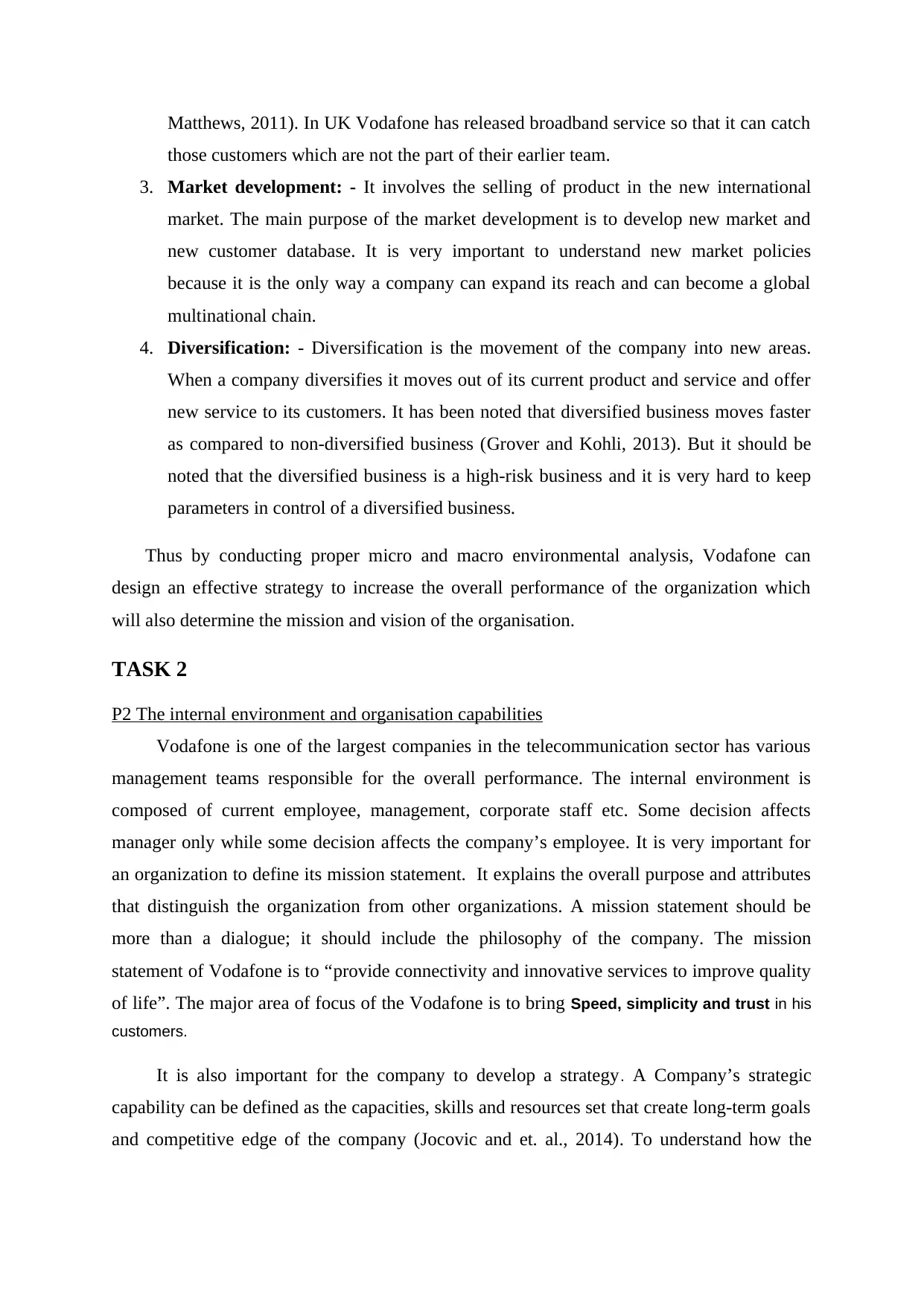
Matthews, 2011). In UK Vodafone has released broadband service so that it can catch
those customers which are not the part of their earlier team.
3. Market development: - It involves the selling of product in the new international
market. The main purpose of the market development is to develop new market and
new customer database. It is very important to understand new market policies
because it is the only way a company can expand its reach and can become a global
multinational chain.
4. Diversification: - Diversification is the movement of the company into new areas.
When a company diversifies it moves out of its current product and service and offer
new service to its customers. It has been noted that diversified business moves faster
as compared to non-diversified business (Grover and Kohli, 2013). But it should be
noted that the diversified business is a high-risk business and it is very hard to keep
parameters in control of a diversified business.
Thus by conducting proper micro and macro environmental analysis, Vodafone can
design an effective strategy to increase the overall performance of the organization which
will also determine the mission and vision of the organisation.
TASK 2
P2 The internal environment and organisation capabilities
Vodafone is one of the largest companies in the telecommunication sector has various
management teams responsible for the overall performance. The internal environment is
composed of current employee, management, corporate staff etc. Some decision affects
manager only while some decision affects the company’s employee. It is very important for
an organization to define its mission statement. It explains the overall purpose and attributes
that distinguish the organization from other organizations. A mission statement should be
more than a dialogue; it should include the philosophy of the company. The mission
statement of Vodafone is to “provide connectivity and innovative services to improve quality
of life”. The major area of focus of the Vodafone is to bring Speed, simplicity and trust in his
customers.
It is also important for the company to develop a strategy. A Company’s strategic
capability can be defined as the capacities, skills and resources set that create long-term goals
and competitive edge of the company (Jocovic and et. al., 2014). To understand how the
those customers which are not the part of their earlier team.
3. Market development: - It involves the selling of product in the new international
market. The main purpose of the market development is to develop new market and
new customer database. It is very important to understand new market policies
because it is the only way a company can expand its reach and can become a global
multinational chain.
4. Diversification: - Diversification is the movement of the company into new areas.
When a company diversifies it moves out of its current product and service and offer
new service to its customers. It has been noted that diversified business moves faster
as compared to non-diversified business (Grover and Kohli, 2013). But it should be
noted that the diversified business is a high-risk business and it is very hard to keep
parameters in control of a diversified business.
Thus by conducting proper micro and macro environmental analysis, Vodafone can
design an effective strategy to increase the overall performance of the organization which
will also determine the mission and vision of the organisation.
TASK 2
P2 The internal environment and organisation capabilities
Vodafone is one of the largest companies in the telecommunication sector has various
management teams responsible for the overall performance. The internal environment is
composed of current employee, management, corporate staff etc. Some decision affects
manager only while some decision affects the company’s employee. It is very important for
an organization to define its mission statement. It explains the overall purpose and attributes
that distinguish the organization from other organizations. A mission statement should be
more than a dialogue; it should include the philosophy of the company. The mission
statement of Vodafone is to “provide connectivity and innovative services to improve quality
of life”. The major area of focus of the Vodafone is to bring Speed, simplicity and trust in his
customers.
It is also important for the company to develop a strategy. A Company’s strategic
capability can be defined as the capacities, skills and resources set that create long-term goals
and competitive edge of the company (Jocovic and et. al., 2014). To understand how the
⊘ This is a preview!⊘
Do you want full access?
Subscribe today to unlock all pages.

Trusted by 1+ million students worldwide
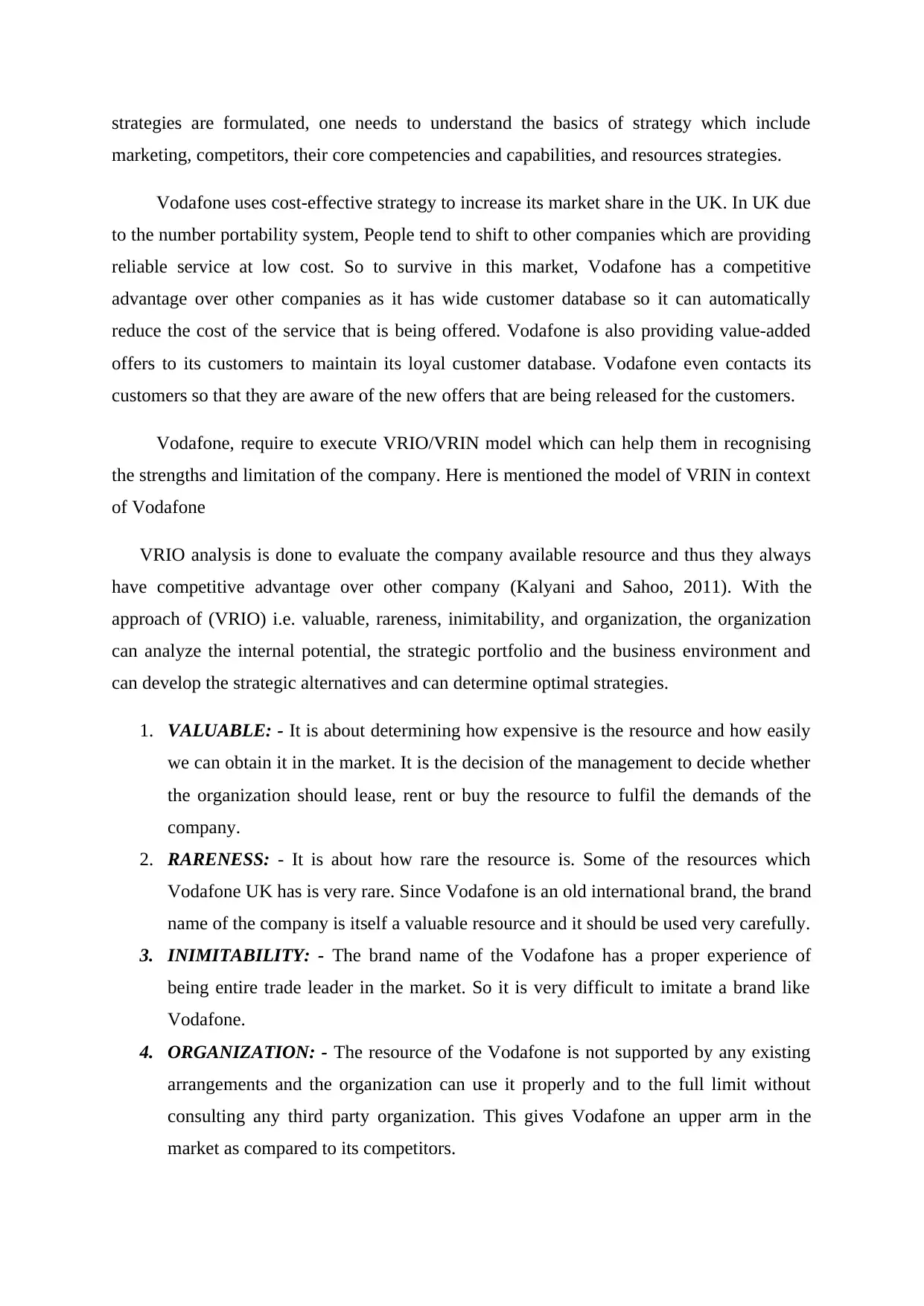
strategies are formulated, one needs to understand the basics of strategy which include
marketing, competitors, their core competencies and capabilities, and resources strategies.
Vodafone uses cost-effective strategy to increase its market share in the UK. In UK due
to the number portability system, People tend to shift to other companies which are providing
reliable service at low cost. So to survive in this market, Vodafone has a competitive
advantage over other companies as it has wide customer database so it can automatically
reduce the cost of the service that is being offered. Vodafone is also providing value-added
offers to its customers to maintain its loyal customer database. Vodafone even contacts its
customers so that they are aware of the new offers that are being released for the customers.
Vodafone, require to execute VRIO/VRIN model which can help them in recognising
the strengths and limitation of the company. Here is mentioned the model of VRIN in context
of Vodafone
VRIO analysis is done to evaluate the company available resource and thus they always
have competitive advantage over other company (Kalyani and Sahoo, 2011). With the
approach of (VRIO) i.e. valuable, rareness, inimitability, and organization, the organization
can analyze the internal potential, the strategic portfolio and the business environment and
can develop the strategic alternatives and can determine optimal strategies.
1. VALUABLE: - It is about determining how expensive is the resource and how easily
we can obtain it in the market. It is the decision of the management to decide whether
the organization should lease, rent or buy the resource to fulfil the demands of the
company.
2. RARENESS: - It is about how rare the resource is. Some of the resources which
Vodafone UK has is very rare. Since Vodafone is an old international brand, the brand
name of the company is itself a valuable resource and it should be used very carefully.
3. INIMITABILITY: - The brand name of the Vodafone has a proper experience of
being entire trade leader in the market. So it is very difficult to imitate a brand like
Vodafone.
4. ORGANIZATION: - The resource of the Vodafone is not supported by any existing
arrangements and the organization can use it properly and to the full limit without
consulting any third party organization. This gives Vodafone an upper arm in the
market as compared to its competitors.
marketing, competitors, their core competencies and capabilities, and resources strategies.
Vodafone uses cost-effective strategy to increase its market share in the UK. In UK due
to the number portability system, People tend to shift to other companies which are providing
reliable service at low cost. So to survive in this market, Vodafone has a competitive
advantage over other companies as it has wide customer database so it can automatically
reduce the cost of the service that is being offered. Vodafone is also providing value-added
offers to its customers to maintain its loyal customer database. Vodafone even contacts its
customers so that they are aware of the new offers that are being released for the customers.
Vodafone, require to execute VRIO/VRIN model which can help them in recognising
the strengths and limitation of the company. Here is mentioned the model of VRIN in context
of Vodafone
VRIO analysis is done to evaluate the company available resource and thus they always
have competitive advantage over other company (Kalyani and Sahoo, 2011). With the
approach of (VRIO) i.e. valuable, rareness, inimitability, and organization, the organization
can analyze the internal potential, the strategic portfolio and the business environment and
can develop the strategic alternatives and can determine optimal strategies.
1. VALUABLE: - It is about determining how expensive is the resource and how easily
we can obtain it in the market. It is the decision of the management to decide whether
the organization should lease, rent or buy the resource to fulfil the demands of the
company.
2. RARENESS: - It is about how rare the resource is. Some of the resources which
Vodafone UK has is very rare. Since Vodafone is an old international brand, the brand
name of the company is itself a valuable resource and it should be used very carefully.
3. INIMITABILITY: - The brand name of the Vodafone has a proper experience of
being entire trade leader in the market. So it is very difficult to imitate a brand like
Vodafone.
4. ORGANIZATION: - The resource of the Vodafone is not supported by any existing
arrangements and the organization can use it properly and to the full limit without
consulting any third party organization. This gives Vodafone an upper arm in the
market as compared to its competitors.
Paraphrase This Document
Need a fresh take? Get an instant paraphrase of this document with our AI Paraphraser

STRENGTHS AND WEAKNESS OF ORGANISATION
Vodafone is one of the largest telecom brands in the UK and it is second in the
number of connections in the world. After the evaluation of VRIN analysis, the company can
conveniently determine their main limitation and strengths and it very important for the
company to determine them.
One of the biggest advantages of Vodafone is its brand name which has trust
associated with it. So the company can introduce its product anywhere in the world and
people will trust the product just on the basis of the brand name (Klettner, Clarke and
Boersma, 2014). Vodafone also focuses on the research and development and innovate their
product all the times. Recently just to enter the new market, Vodafone has introduced fibre
broadband network so that it can make its presence strong in the UK market.
In this ever-changing global environment, it is very important for a company to
partner with the global leaders of other domain so that they can cater the needs of their
customers. To follow these strategies the Vodafone CEO has partnered with HPE which will
allow them to introduce new products and latest features to their clients at much faster speed
and cheaper rates. It also enhanced their technical capabilities as HPE was a leader in the
broadband industry and cloud solution business.
Vodafone is also investing a huge amount of money in training and development programme.
It ensures that they have the right skills and talent ready in the near future. For that Vodafone
conduct an annual analysis of learning needs to identify the priorities and ensure that learning
plans support the future business strategy. The major domain in which Vodafone train its
trainee is Marketing, Technology, Sales, Retail and they work with worlds most renowned
business schools in order to impart the best training to their candidates (Köseoglu and et. al.,
2013). One of the biggest weaknesses of Vodafone is the dropping customer base in its home
country UK. Due to Brexit, the economy of Britain is in severe collapse and due to this
Vodafone is severely affected. Drop in customer database can be seen continuously in past
few years. Even the US market is running in loss. IN US both AT &T and Verizon are
working better than Vodafone.
Another weakness of Vodafone is the reduction in dependency of people over cellular
network and increase in dependency over the wifi network. It is simple. If a person can see
Vodafone is one of the largest telecom brands in the UK and it is second in the
number of connections in the world. After the evaluation of VRIN analysis, the company can
conveniently determine their main limitation and strengths and it very important for the
company to determine them.
One of the biggest advantages of Vodafone is its brand name which has trust
associated with it. So the company can introduce its product anywhere in the world and
people will trust the product just on the basis of the brand name (Klettner, Clarke and
Boersma, 2014). Vodafone also focuses on the research and development and innovate their
product all the times. Recently just to enter the new market, Vodafone has introduced fibre
broadband network so that it can make its presence strong in the UK market.
In this ever-changing global environment, it is very important for a company to
partner with the global leaders of other domain so that they can cater the needs of their
customers. To follow these strategies the Vodafone CEO has partnered with HPE which will
allow them to introduce new products and latest features to their clients at much faster speed
and cheaper rates. It also enhanced their technical capabilities as HPE was a leader in the
broadband industry and cloud solution business.
Vodafone is also investing a huge amount of money in training and development programme.
It ensures that they have the right skills and talent ready in the near future. For that Vodafone
conduct an annual analysis of learning needs to identify the priorities and ensure that learning
plans support the future business strategy. The major domain in which Vodafone train its
trainee is Marketing, Technology, Sales, Retail and they work with worlds most renowned
business schools in order to impart the best training to their candidates (Köseoglu and et. al.,
2013). One of the biggest weaknesses of Vodafone is the dropping customer base in its home
country UK. Due to Brexit, the economy of Britain is in severe collapse and due to this
Vodafone is severely affected. Drop in customer database can be seen continuously in past
few years. Even the US market is running in loss. IN US both AT &T and Verizon are
working better than Vodafone.
Another weakness of Vodafone is the reduction in dependency of people over cellular
network and increase in dependency over the wifi network. It is simple. If a person can see
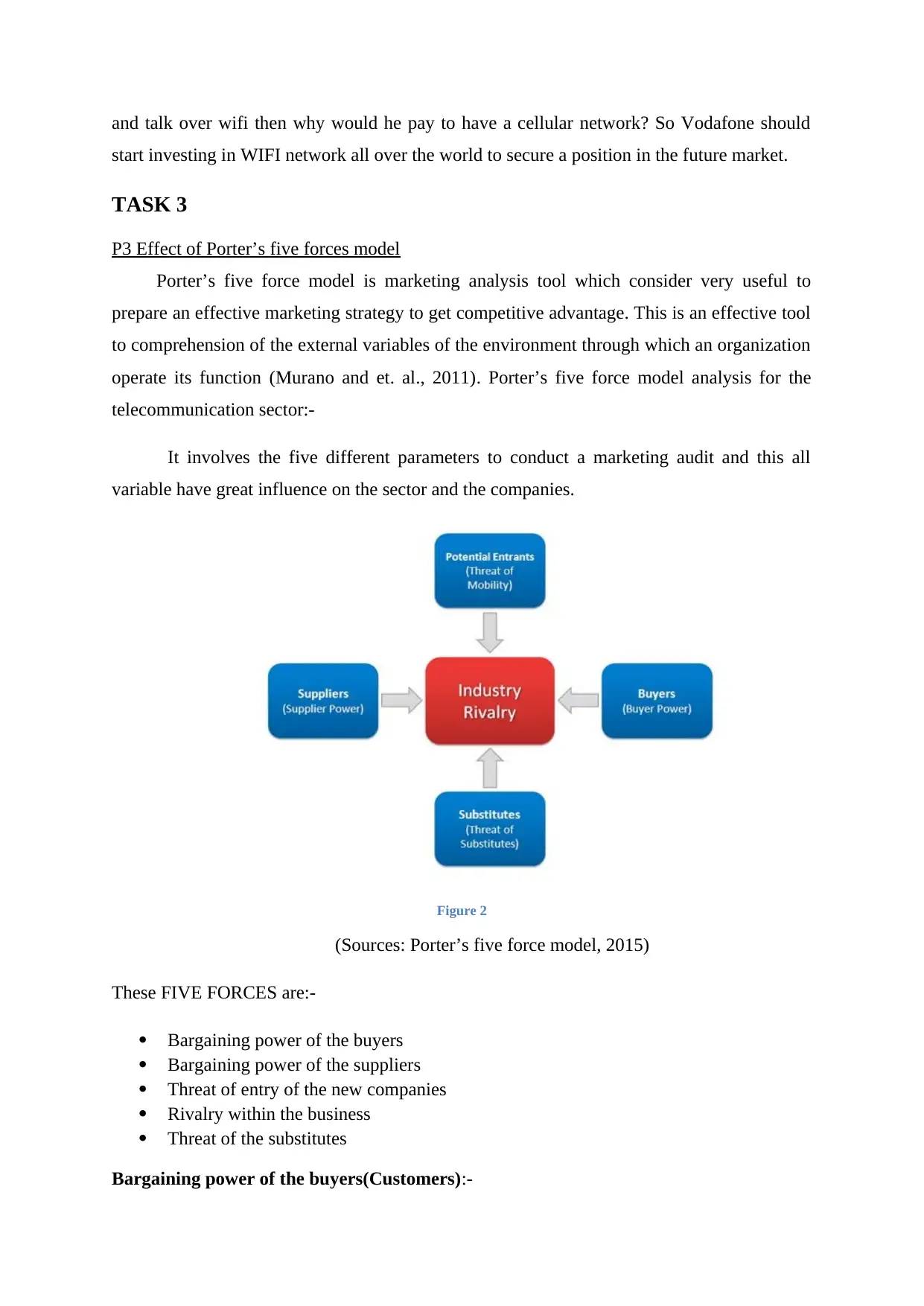
and talk over wifi then why would he pay to have a cellular network? So Vodafone should
start investing in WIFI network all over the world to secure a position in the future market.
TASK 3
P3 Effect of Porter’s five forces model
Porter’s five force model is marketing analysis tool which consider very useful to
prepare an effective marketing strategy to get competitive advantage. This is an effective tool
to comprehension of the external variables of the environment through which an organization
operate its function (Murano and et. al., 2011). Porter’s five force model analysis for the
telecommunication sector:-
It involves the five different parameters to conduct a marketing audit and this all
variable have great influence on the sector and the companies.
Figure 2
(Sources: Porter’s five force model, 2015)
These FIVE FORCES are:-
Bargaining power of the buyers
Bargaining power of the suppliers
Threat of entry of the new companies
Rivalry within the business
Threat of the substitutes
Bargaining power of the buyers(Customers):-
start investing in WIFI network all over the world to secure a position in the future market.
TASK 3
P3 Effect of Porter’s five forces model
Porter’s five force model is marketing analysis tool which consider very useful to
prepare an effective marketing strategy to get competitive advantage. This is an effective tool
to comprehension of the external variables of the environment through which an organization
operate its function (Murano and et. al., 2011). Porter’s five force model analysis for the
telecommunication sector:-
It involves the five different parameters to conduct a marketing audit and this all
variable have great influence on the sector and the companies.
Figure 2
(Sources: Porter’s five force model, 2015)
These FIVE FORCES are:-
Bargaining power of the buyers
Bargaining power of the suppliers
Threat of entry of the new companies
Rivalry within the business
Threat of the substitutes
Bargaining power of the buyers(Customers):-
⊘ This is a preview!⊘
Do you want full access?
Subscribe today to unlock all pages.

Trusted by 1+ million students worldwide
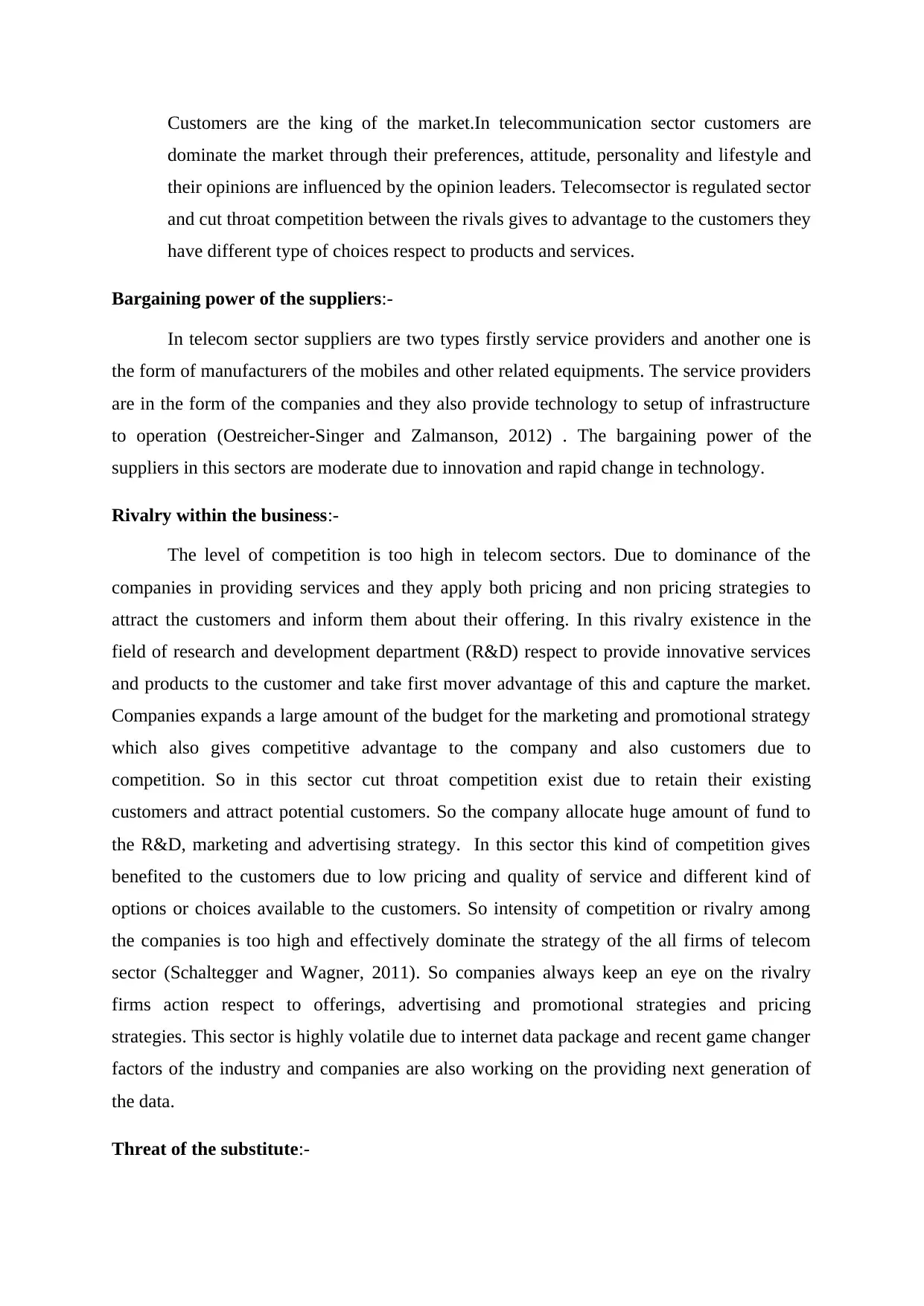
Customers are the king of the market.In telecommunication sector customers are
dominate the market through their preferences, attitude, personality and lifestyle and
their opinions are influenced by the opinion leaders. Telecomsector is regulated sector
and cut throat competition between the rivals gives to advantage to the customers they
have different type of choices respect to products and services.
Bargaining power of the suppliers:-
In telecom sector suppliers are two types firstly service providers and another one is
the form of manufacturers of the mobiles and other related equipments. The service providers
are in the form of the companies and they also provide technology to setup of infrastructure
to operation (Oestreicher-Singer and Zalmanson, 2012) . The bargaining power of the
suppliers in this sectors are moderate due to innovation and rapid change in technology.
Rivalry within the business:-
The level of competition is too high in telecom sectors. Due to dominance of the
companies in providing services and they apply both pricing and non pricing strategies to
attract the customers and inform them about their offering. In this rivalry existence in the
field of research and development department (R&D) respect to provide innovative services
and products to the customer and take first mover advantage of this and capture the market.
Companies expands a large amount of the budget for the marketing and promotional strategy
which also gives competitive advantage to the company and also customers due to
competition. So in this sector cut throat competition exist due to retain their existing
customers and attract potential customers. So the company allocate huge amount of fund to
the R&D, marketing and advertising strategy. In this sector this kind of competition gives
benefited to the customers due to low pricing and quality of service and different kind of
options or choices available to the customers. So intensity of competition or rivalry among
the companies is too high and effectively dominate the strategy of the all firms of telecom
sector (Schaltegger and Wagner, 2011). So companies always keep an eye on the rivalry
firms action respect to offerings, advertising and promotional strategies and pricing
strategies. This sector is highly volatile due to internet data package and recent game changer
factors of the industry and companies are also working on the providing next generation of
the data.
Threat of the substitute:-
dominate the market through their preferences, attitude, personality and lifestyle and
their opinions are influenced by the opinion leaders. Telecomsector is regulated sector
and cut throat competition between the rivals gives to advantage to the customers they
have different type of choices respect to products and services.
Bargaining power of the suppliers:-
In telecom sector suppliers are two types firstly service providers and another one is
the form of manufacturers of the mobiles and other related equipments. The service providers
are in the form of the companies and they also provide technology to setup of infrastructure
to operation (Oestreicher-Singer and Zalmanson, 2012) . The bargaining power of the
suppliers in this sectors are moderate due to innovation and rapid change in technology.
Rivalry within the business:-
The level of competition is too high in telecom sectors. Due to dominance of the
companies in providing services and they apply both pricing and non pricing strategies to
attract the customers and inform them about their offering. In this rivalry existence in the
field of research and development department (R&D) respect to provide innovative services
and products to the customer and take first mover advantage of this and capture the market.
Companies expands a large amount of the budget for the marketing and promotional strategy
which also gives competitive advantage to the company and also customers due to
competition. So in this sector cut throat competition exist due to retain their existing
customers and attract potential customers. So the company allocate huge amount of fund to
the R&D, marketing and advertising strategy. In this sector this kind of competition gives
benefited to the customers due to low pricing and quality of service and different kind of
options or choices available to the customers. So intensity of competition or rivalry among
the companies is too high and effectively dominate the strategy of the all firms of telecom
sector (Schaltegger and Wagner, 2011). So companies always keep an eye on the rivalry
firms action respect to offerings, advertising and promotional strategies and pricing
strategies. This sector is highly volatile due to internet data package and recent game changer
factors of the industry and companies are also working on the providing next generation of
the data.
Threat of the substitute:-
Paraphrase This Document
Need a fresh take? Get an instant paraphrase of this document with our AI Paraphraser
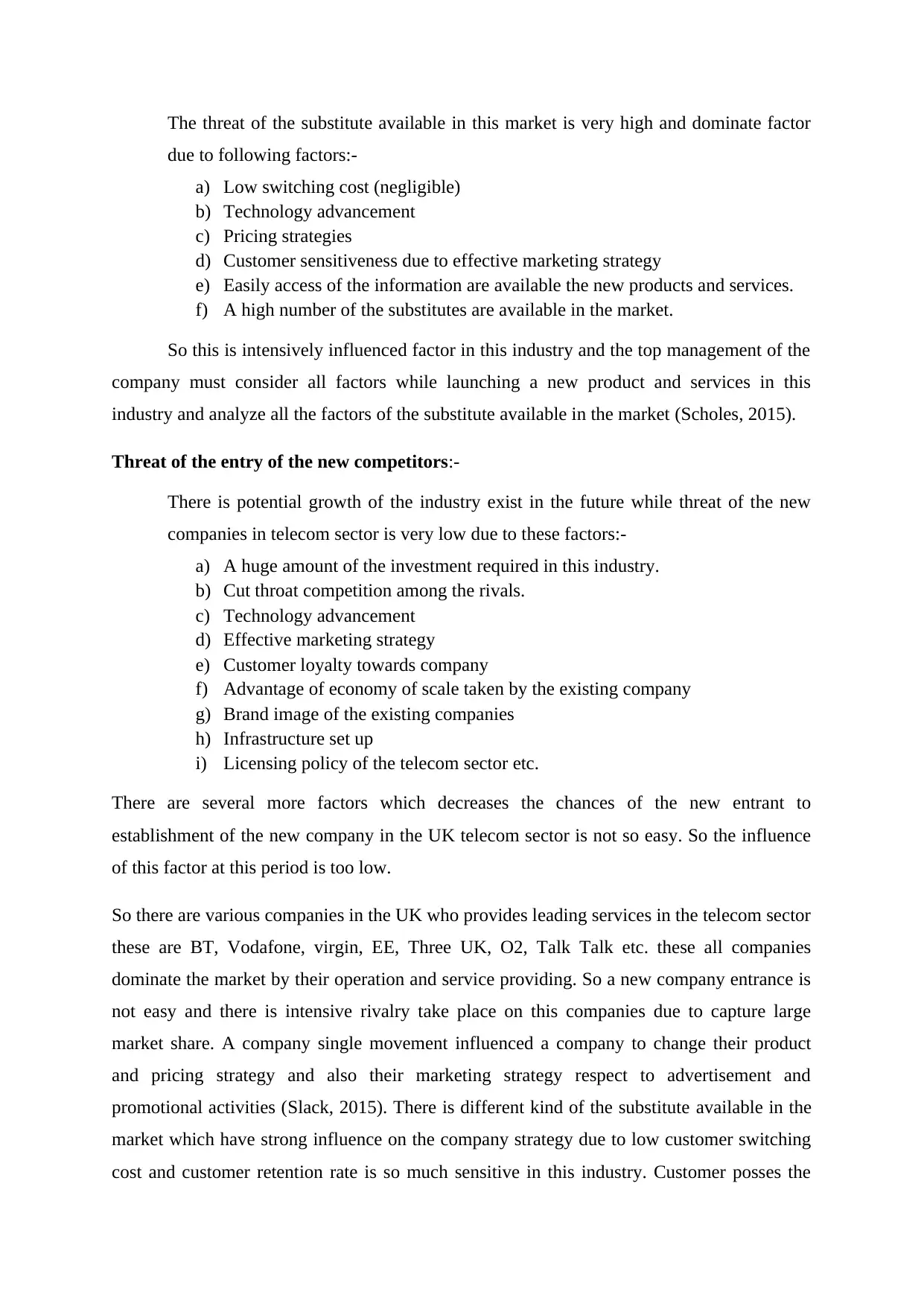
The threat of the substitute available in this market is very high and dominate factor
due to following factors:-
a) Low switching cost (negligible)
b) Technology advancement
c) Pricing strategies
d) Customer sensitiveness due to effective marketing strategy
e) Easily access of the information are available the new products and services.
f) A high number of the substitutes are available in the market.
So this is intensively influenced factor in this industry and the top management of the
company must consider all factors while launching a new product and services in this
industry and analyze all the factors of the substitute available in the market (Scholes, 2015).
Threat of the entry of the new competitors:-
There is potential growth of the industry exist in the future while threat of the new
companies in telecom sector is very low due to these factors:-
a) A huge amount of the investment required in this industry.
b) Cut throat competition among the rivals.
c) Technology advancement
d) Effective marketing strategy
e) Customer loyalty towards company
f) Advantage of economy of scale taken by the existing company
g) Brand image of the existing companies
h) Infrastructure set up
i) Licensing policy of the telecom sector etc.
There are several more factors which decreases the chances of the new entrant to
establishment of the new company in the UK telecom sector is not so easy. So the influence
of this factor at this period is too low.
So there are various companies in the UK who provides leading services in the telecom sector
these are BT, Vodafone, virgin, EE, Three UK, O2, Talk Talk etc. these all companies
dominate the market by their operation and service providing. So a new company entrance is
not easy and there is intensive rivalry take place on this companies due to capture large
market share. A company single movement influenced a company to change their product
and pricing strategy and also their marketing strategy respect to advertisement and
promotional activities (Slack, 2015). There is different kind of the substitute available in the
market which have strong influence on the company strategy due to low customer switching
cost and customer retention rate is so much sensitive in this industry. Customer posses the
due to following factors:-
a) Low switching cost (negligible)
b) Technology advancement
c) Pricing strategies
d) Customer sensitiveness due to effective marketing strategy
e) Easily access of the information are available the new products and services.
f) A high number of the substitutes are available in the market.
So this is intensively influenced factor in this industry and the top management of the
company must consider all factors while launching a new product and services in this
industry and analyze all the factors of the substitute available in the market (Scholes, 2015).
Threat of the entry of the new competitors:-
There is potential growth of the industry exist in the future while threat of the new
companies in telecom sector is very low due to these factors:-
a) A huge amount of the investment required in this industry.
b) Cut throat competition among the rivals.
c) Technology advancement
d) Effective marketing strategy
e) Customer loyalty towards company
f) Advantage of economy of scale taken by the existing company
g) Brand image of the existing companies
h) Infrastructure set up
i) Licensing policy of the telecom sector etc.
There are several more factors which decreases the chances of the new entrant to
establishment of the new company in the UK telecom sector is not so easy. So the influence
of this factor at this period is too low.
So there are various companies in the UK who provides leading services in the telecom sector
these are BT, Vodafone, virgin, EE, Three UK, O2, Talk Talk etc. these all companies
dominate the market by their operation and service providing. So a new company entrance is
not easy and there is intensive rivalry take place on this companies due to capture large
market share. A company single movement influenced a company to change their product
and pricing strategy and also their marketing strategy respect to advertisement and
promotional activities (Slack, 2015). There is different kind of the substitute available in the
market which have strong influence on the company strategy due to low customer switching
cost and customer retention rate is so much sensitive in this industry. Customer posses the
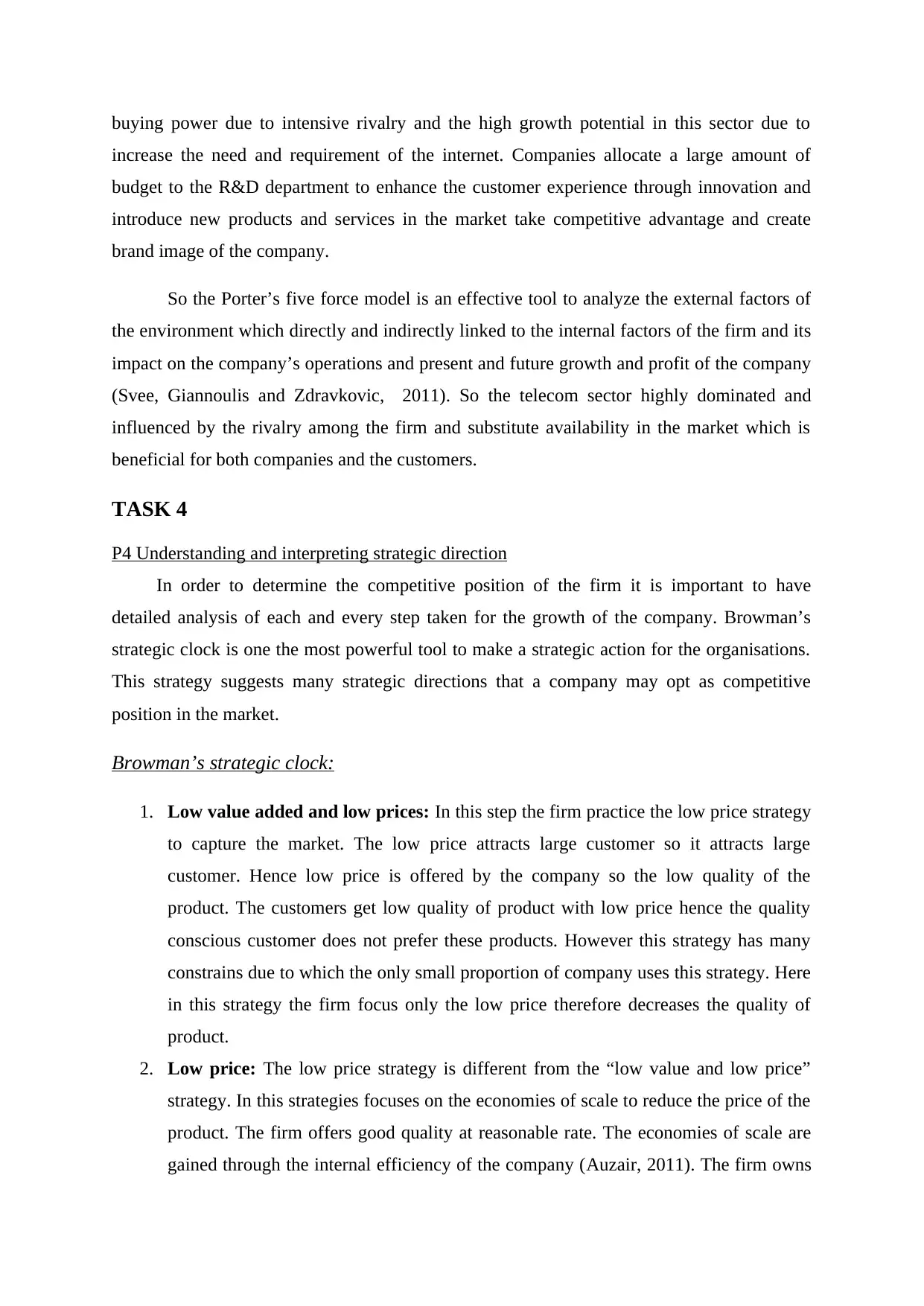
buying power due to intensive rivalry and the high growth potential in this sector due to
increase the need and requirement of the internet. Companies allocate a large amount of
budget to the R&D department to enhance the customer experience through innovation and
introduce new products and services in the market take competitive advantage and create
brand image of the company.
So the Porter’s five force model is an effective tool to analyze the external factors of
the environment which directly and indirectly linked to the internal factors of the firm and its
impact on the company’s operations and present and future growth and profit of the company
(Svee, Giannoulis and Zdravkovic, 2011). So the telecom sector highly dominated and
influenced by the rivalry among the firm and substitute availability in the market which is
beneficial for both companies and the customers.
TASK 4
P4 Understanding and interpreting strategic direction
In order to determine the competitive position of the firm it is important to have
detailed analysis of each and every step taken for the growth of the company. Browman’s
strategic clock is one the most powerful tool to make a strategic action for the organisations.
This strategy suggests many strategic directions that a company may opt as competitive
position in the market.
Browman’s strategic clock:
1. Low value added and low prices: In this step the firm practice the low price strategy
to capture the market. The low price attracts large customer so it attracts large
customer. Hence low price is offered by the company so the low quality of the
product. The customers get low quality of product with low price hence the quality
conscious customer does not prefer these products. However this strategy has many
constrains due to which the only small proportion of company uses this strategy. Here
in this strategy the firm focus only the low price therefore decreases the quality of
product.
2. Low price: The low price strategy is different from the “low value and low price”
strategy. In this strategies focuses on the economies of scale to reduce the price of the
product. The firm offers good quality at reasonable rate. The economies of scale are
gained through the internal efficiency of the company (Auzair, 2011). The firm owns
increase the need and requirement of the internet. Companies allocate a large amount of
budget to the R&D department to enhance the customer experience through innovation and
introduce new products and services in the market take competitive advantage and create
brand image of the company.
So the Porter’s five force model is an effective tool to analyze the external factors of
the environment which directly and indirectly linked to the internal factors of the firm and its
impact on the company’s operations and present and future growth and profit of the company
(Svee, Giannoulis and Zdravkovic, 2011). So the telecom sector highly dominated and
influenced by the rivalry among the firm and substitute availability in the market which is
beneficial for both companies and the customers.
TASK 4
P4 Understanding and interpreting strategic direction
In order to determine the competitive position of the firm it is important to have
detailed analysis of each and every step taken for the growth of the company. Browman’s
strategic clock is one the most powerful tool to make a strategic action for the organisations.
This strategy suggests many strategic directions that a company may opt as competitive
position in the market.
Browman’s strategic clock:
1. Low value added and low prices: In this step the firm practice the low price strategy
to capture the market. The low price attracts large customer so it attracts large
customer. Hence low price is offered by the company so the low quality of the
product. The customers get low quality of product with low price hence the quality
conscious customer does not prefer these products. However this strategy has many
constrains due to which the only small proportion of company uses this strategy. Here
in this strategy the firm focus only the low price therefore decreases the quality of
product.
2. Low price: The low price strategy is different from the “low value and low price”
strategy. In this strategies focuses on the economies of scale to reduce the price of the
product. The firm offers good quality at reasonable rate. The economies of scale are
gained through the internal efficiency of the company (Auzair, 2011). The firm owns
⊘ This is a preview!⊘
Do you want full access?
Subscribe today to unlock all pages.

Trusted by 1+ million students worldwide
1 out of 16
Related Documents
Your All-in-One AI-Powered Toolkit for Academic Success.
+13062052269
info@desklib.com
Available 24*7 on WhatsApp / Email
![[object Object]](/_next/static/media/star-bottom.7253800d.svg)
Unlock your academic potential
Copyright © 2020–2025 A2Z Services. All Rights Reserved. Developed and managed by ZUCOL.




